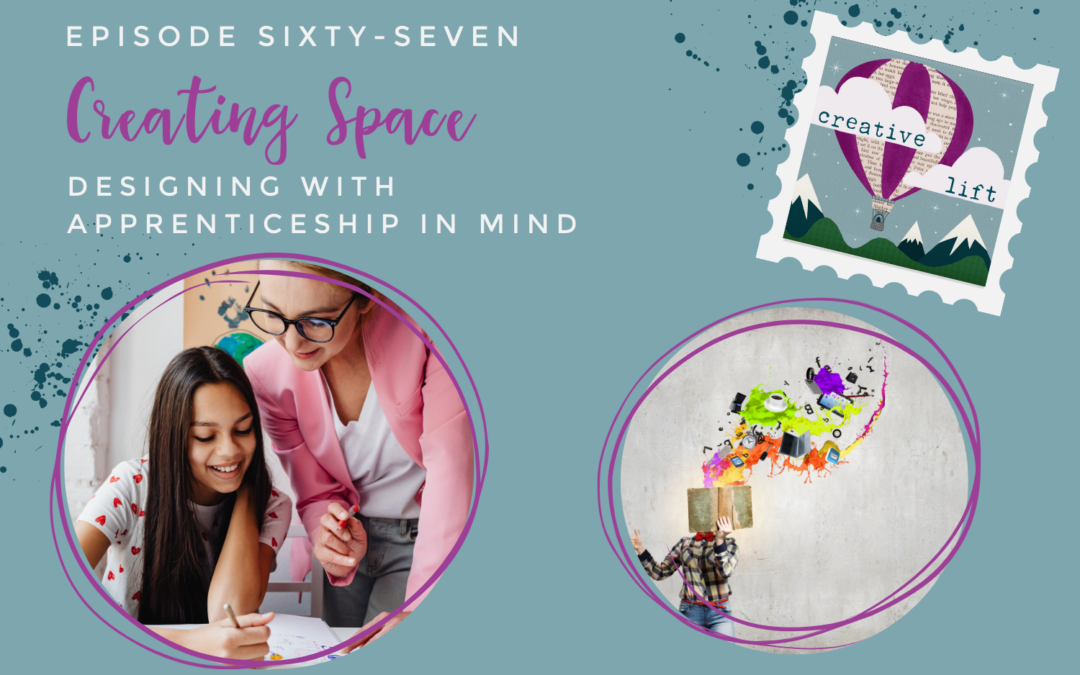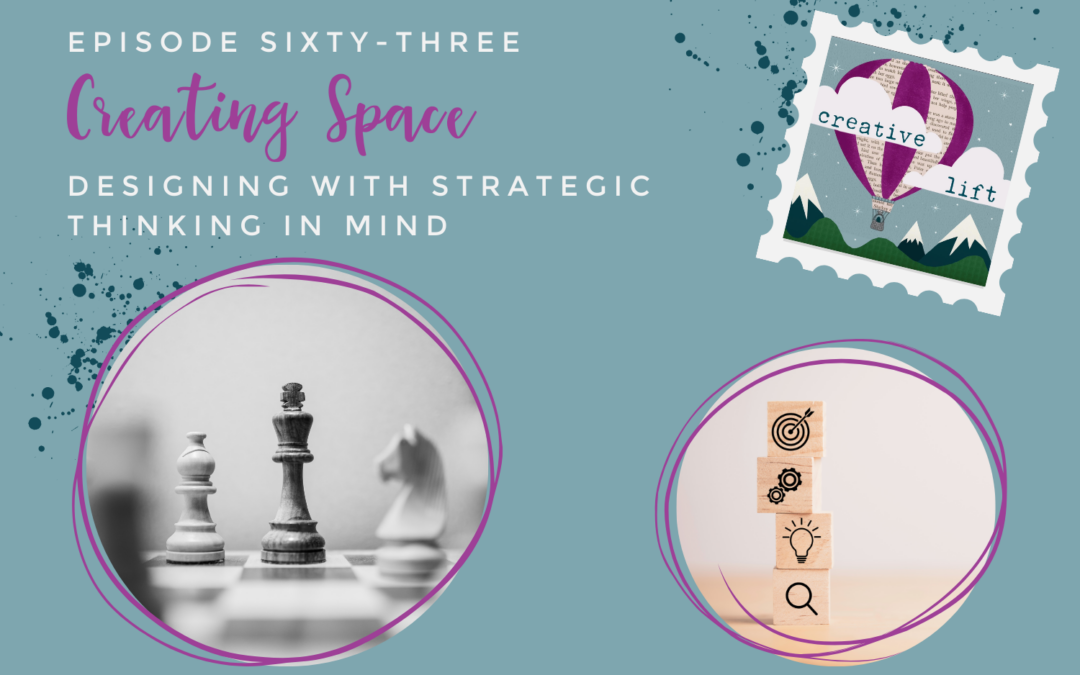by Naomi | Mar 6, 2018 | Creative Life
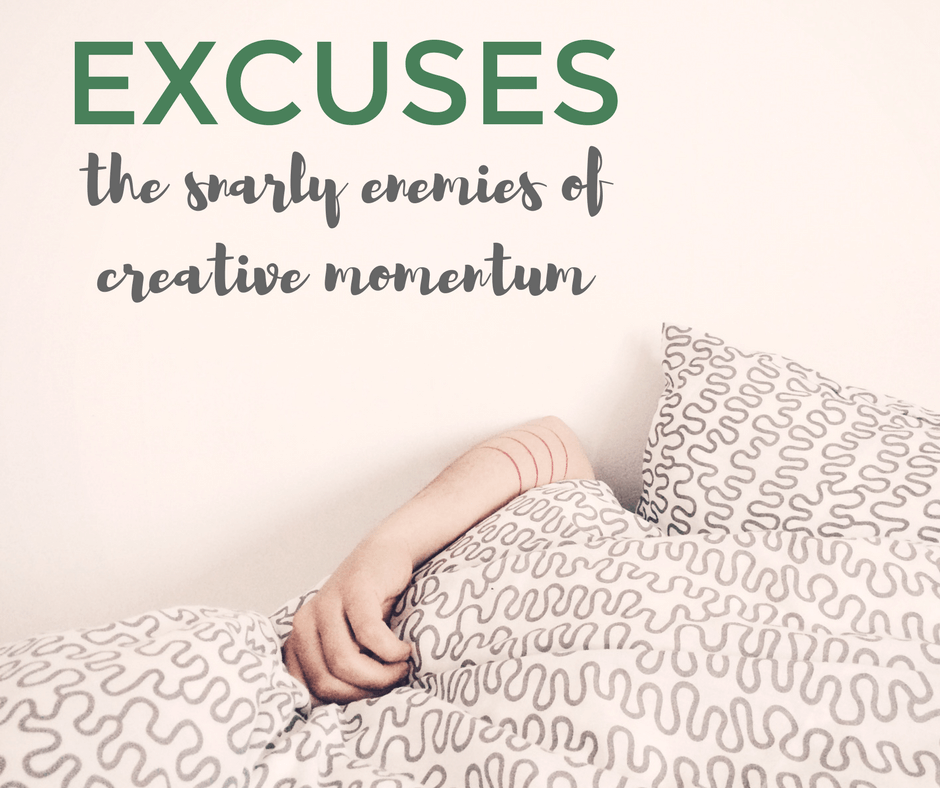
I’m not a fan of excuses.
And, not in a blow a whistle and shout, “Get to work!” kind of way. More in a roll-up-my-sleeves, experiment-until-you-figure-it-out kind of way.
Excuses are snarly enemies of momentum. They snap at our heels and grab for us with grubby little fingers, hoping to drag us into inertia quicksand. Once we’re sunk, wow is it difficult to scrabble our way free.
A large part of my job, working with educators, with students, with artists, with my team at Society of Young Inklings, is to glare excuses in the face and say, “Not on my watch.” So, it’s probably not surprising that I feel particularly grumpy when I wake to the sound of excuses throwing a dance party at the foot of my bed.
Here we are. It’s March 5, and my last blog post was on January 20. For the larger part of 2017, I posted once a month or so. Now, there are definitely reasons. For one, I’ve been posting more regularly over at Society of Young Inklings because we’re in the midst of a (very exciting) growth curve at our nonprofit for youth writers. Also, I’ve been hard at work backstage on larger creative projects that I can’t share just yet.
Still, to me, these reasons have the sharp scent of excuse to them.
Knowing that I mean to blog, and don’t, takes wind out of my sails every week. Over time, I prove to myself that I’m the sort of person who plans but doesn’t necessarily follow through. My confidence erodes. My optimism suffers. The excuses pole-vault from one area of my life to another and before I know it, my life’s rhythm is completely out of whack.
Today, I’d finally had enough. I decided to hop online and share a little of my thinking real-time. Maybe you’ve had situations like the one I’m in, where you realized that your expectations and your reality weren’t matching up. What did you do?
Here’s what I’m thinking.
- I could take an official break from the blog. This would be a reasonable strategy, and would send the excuses packing. Unfortunately, it would also mean I couldn’t blog, which is a problem. In the past few weeks, I’ve actually been prepping for a more regular editorial calendar. I’m looking forward to blogging regularly … I’m just not quite ready yet.
- I could set a launch date for my new approach and build toward it. While a date is also a deadline, I actually like the sound of this possibility. It gives me breathing room, and also a healthy dose of accountability.
- I could force myself to start today and carry on, posting once a week, rain or shine. But, you deserve my very best. My posts ought to rattle fresh creativity loose for you, or at the least, send you back to your projects with renewed enthusiasm. If I bully myself into blogging when I’m not ready, I fear I might inspire you to bully yourself, too. No, thank you.
- Or, I could decide to close down the blog. But, I love writing from my heart to yours. So, for me, that’s really not an option.
I may have found a solution in the possible launch date, but I want to explore how to make it a viable one for the long run. Because the truth is, my bandwidth for producing meaningful content will ebb and flow. As an author, book deadlines come before blog intentions. As a founder and Executive Director, the stability and health of Society of Young Inklings are also top priority. And beyond work commitments, I have health, family, friends, to name a few. And life isn’t always predictable.
Over the years, I’ve learned a lot of excuse-extermination strategies. Most often, I return to the simple question starter: “How might I…”
Step One: Craft a question to focus my attention tightly on the problem.
How might I be realistic, true to my priorities, realistic, and make an excuse-free commitment?
Step Two: Brainstorm options.
- Commit to post infrequently, maybe once a month.
- Repurpose old posts along with the new ones.
- Create some short-form post formats. Every post doesn’t have to be epic. (Readers appreciate short, too!)
Step Three: Choose an approach and experiment.
I think I’ll commit to starting the blog again on April 3. I’ll post on Tuesdays and possibly add a bonus post on Thursdays. Some posts will be small. I’m not going to demand perfection. If I’m in a busy season, I’ll show up on Tuesday and tell you so. It might just be a sentence or two. But what I learned writing this post, (and here’s what I hope might be applicable to you, too) is that even mid-process, our thoughts can be useful.
Are you battling excuses, too? Maybe it’s not a blog for you, but it’s a book, or a painting, or even an exercise routine. Would it help you to stop, ask yourself a focused “How might I …” question and brainstorm solutions?
It certainly gave me a fresh gust of wind in my sails.
Thank you. Knowing that you’re out there, living life, popping by the Writerly Play blog now and again for ideas and inspiration, means more to me than you likely know. Perspective, growth, clarity… I gain all of these and more by shaping my ideas on the page, and especially when I hear back from you. I love hearing what you see and notice and wonder. So, please. Always, always, feel free to reach out and share your experiences, too. Tag me on Facebook or Twitter, or comment below.
Tell me: What expectations do you have for yourself that you’re not sure work right now? How might you adjust those expectations to make life work better?
Or tell me: Have you met the excuse gremlins? What kind of havoc do they cause in your life?
by Naomi | Oct 9, 2017 | Creative Life
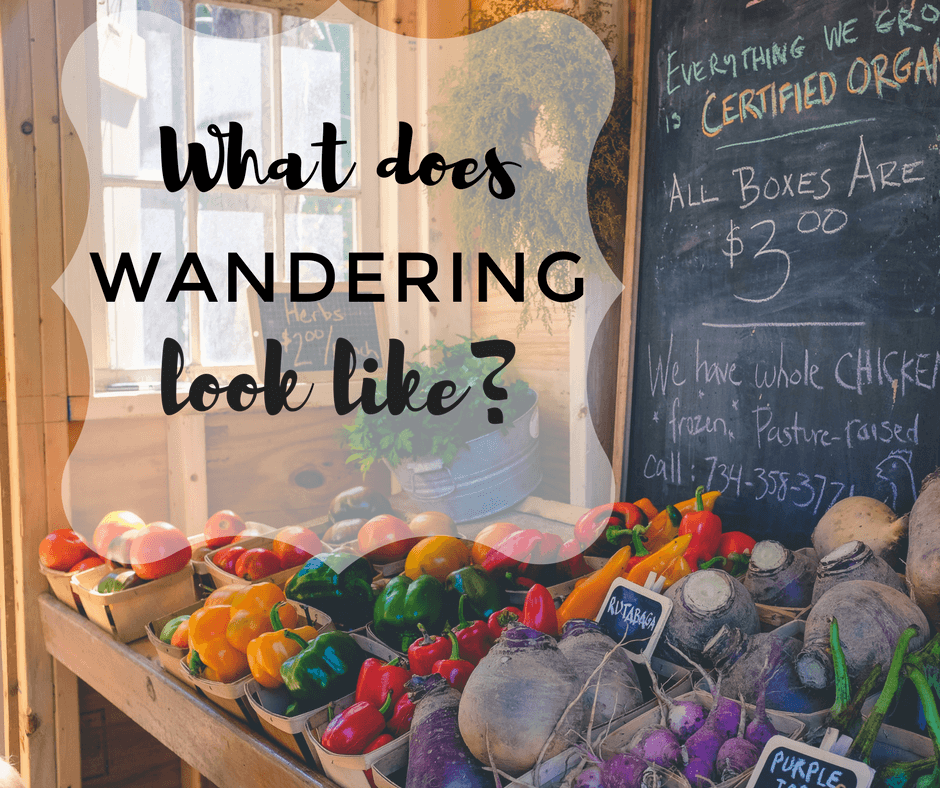
How do you know if something is a waste of time?
A common definition of “waste” is “to use or expend carelessly, extravagantly, or to no purpose. “ Synonyms for waste include squander, misspend, misuse, fritter away, or throw away. No one wants to squander or fritter away time.
But, ask a creative person how she spends her time, and if she’s being honest, she’ll describe work sessions punctuated by time spent in activities which are more difficult to define. Oddly, this time outside work sessions often creates a leap-frogging effect, vaulting work forward in a way that doesn’t happen when one is sitting down at a computer or with pencil and paper.
Unfortunately, the effect doesn’t work if you cut out the work sessions altogether. I’m not arguing that one should wander rather than work. But, there is something to the art of letting go and wandering.
For me, the wandering is literal.
I need to walk around in interesting environments. I need to touch contrasting textures of fabric and smell a variety of loose leaf teas. I need to see interesting patterns and shapes, and listen for contrasting tones of laughter. From the outside, I’m sure this wandering looks like a supreme waste of time. Why am I walking aimlessly, poking into stores, looking through baskets of random antiques, and heading home without buying anything?
I’m collecting. I’m filling up my sensory toolkit so that when I sit down to write, I have words and images and access to the feel of things. Too much time spent at my desk, and my senses dull. Fog settles over my brain and I might stare at my computer screen for ten minutes before coming up with a lackluster sentence. After puzzling over this fog, and how it showed up every now and then, I started to see the pattern.
And I started getting intentional about wandering.
What might speak to your senses?
[Tweet “Where might you wander to collect sights, smells and sounds to infuse your writing with life?”]
Don’t be afraid to carve out time to wander. If you need more encouragement, you’ll definitely enjoy Keri Smith’s intriguing invitation to the art of wandering: The Wander Society.
I’d love to know where you choose to wander! Share your ideas below, or tag me on Twitter or Facebook and let me know what you’re up to. I’m always collecting new ideas for where to wander next.
SaveSave
SaveSaveSaveSave
by Naomi | Apr 6, 2017 | Creative Life
“Life must be lived and curiosity kept alive.”
– Eleanor Roosevelt –
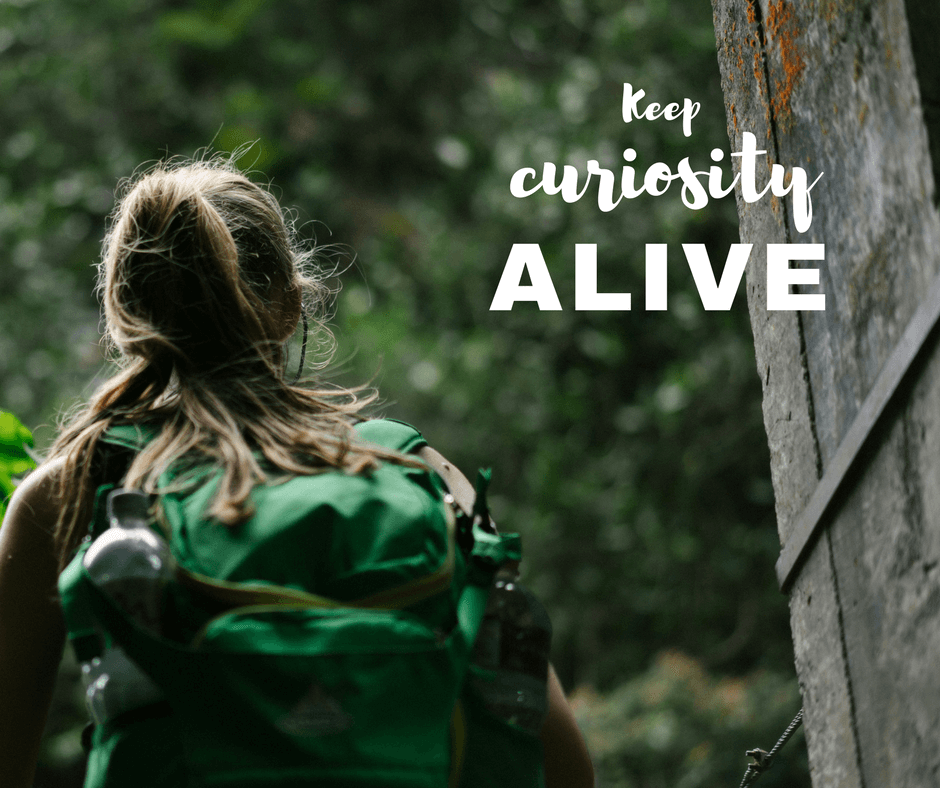
In this article, Eleanor Roosevelt shares her perspective on the importance of curiosity. She notes that curiosity is essential for living fully–it allows us to engage with our world, learn, explore, and find new solutions.
Curiosity is the spark that causes us to look around and connect with one another.
A couple days ago, I listened to a podcast interview with Uli Beutter Cohen, founder of the Subway Book Review project. I’m pretty sure that Uli and Eleanor Roosevelt would have been fast friends. They share a philosophy that every person carries a wealth of stories and life experience. When we are willing to connect, to ask questions, to live a life filled with curiosity, we thrive. What I loved about Uli’s interview was the energy in her voice, the lit-up aliveness that wove through her words as she described her project. She believes that books are an accessory. We put them on like we might put on a hat or scarf. Books may be a more telling accessory than a hat or scarf because they help us get to know a person, especially when the person is willing to share why he or she chose this particular book on this particular day. That’s what Uli’s project is all about: she doesn’t plug into her headphones and tune out on the subway. She asks people about the books they’re reading, and collects stories one at a time.
It’s tempting to look around and think that there are two types of people … the ones who are curious and the ones who are not. It’s more difficult to admit that we each have the capacity for curiosity and the capacity for disinterest. The decision to live with a spirit of curiosity is not a one-time, set-it-and-forget-it choice. That’s why I love the quote from Eleanor Roosevelt above. We must keep our curiosity alive.
What does the care and feeding of curiosity look like?
- Keeping our eyes open
Noticing our surroundings is a choice. It’s a practice, and one that becomes a habit. When we intentionally pay attention to the light in the clouds or the light in faces around us, we are rewarded with beautiful moments. The more we experience those beautiful moments, the more deeply ingrained the habit of paying attention becomes. We teach ourselves the value of an open-eyed approach to life, and with each choice to look around, we remind ourselves of why taking time to notice our world matters.
- Asking questions
When we were three, we asked questions as a way of life. Why was a general response to nearly everything. Then, as we wore down the adults in our lives, we learned to control our inquisitive minds. It’s true that a string of “but why?” questions can be exhausting. When we ask why without any additional context, we place the entire responsibility for knowing the answer on the other person. However, when we ask questions artfully, in a way that invites another person to share their own experience and stories, we aren’t quizzing the world, we’re engaging with it. Like any art, the art of asking questions requires focus and dedicated effort.
- Reflecting on what we see and hear
We reinforce what we focus on. If we focus the majority of our attention on what goes wrong in our lives, our life experience feels like a string of disasters. We remember the irritating email and the car that cut us off on the freeway and the difficult conversation at work. How was our day? From this perspective, it was unhappy. If, instead, we pause and savor the beautiful moments we collect—a story from someone in the elevator, or the exact colors of a sunset, we feel that we live in a world of beauty. Since the difficult situations are usually louder, it takes intention to notice the quieter moments. As with paying attention and asking questions, the effort of reflection is entirely worthwhile. When we reflect, we map a landscape of our lives and our communities that is fueled by—and that further fuels—our curiosity.
When I took my sabbatical last year, I had the opportunity to follow my curiosity. For a full month, I didn’t let a to-do list rule my life. Instead, I let the inner drive that simply wants to know propel me through my days. By the end of the month, I felt whole, calm, restored. What had happened? I’d taken the time to tend to my curiosity, and it made all the difference. I was a little afraid, coming back into my real life, that I would lose that spark as deadlines and expectations settled back in. And sometimes it does feel like I’m losing track of my curiosity. Sometimes I do put my head down and simply push toward finishing a task. Still, that month is fresh in my mind, and it doesn’t take much to set down my work for an hour or two, to tap back into that mindset, and to engage with my world.
How healthy is your curiosity right now?
Have you been able to tend it recently? Do you need a day to wander and to let your questions lead the way? It’s not a waste of time, not even a little bit. So, just in case you need permission … permission granted. Go on, go have an adventure. Let the world surprise you. And once you’ve had your adventure, come on back and share your story with me. I’d love to hear about your experience. Comment below, or connect with me on
Facebook or
Twitter. Let’s follow our curiosity and see where it leads us!
